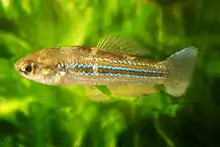Cubanichthys cubensis
Cubanichthys cubensis, the Cuban killifish, is a species of killifish from the family Cyprinodontidae, the pupfishes which is endemic to Cuba.[1]
| Cubanichthys cubensis | |
|---|---|
 | |
| Scientific classification | |
| Domain: | Eukaryota |
| Kingdom: | Animalia |
| Phylum: | Chordata |
| Class: | Actinopterygii |
| Order: | Cyprinodontiformes |
| Family: | Cyprinodontidae |
| Genus: | Cubanichthys |
| Species: | C. cubensis |
| Binomial name | |
| Cubanichthys cubensis (Eigenmann, 1903) | |
| Synonyms[1] | |
|
Fundulus cubensis Eigenmann, 1903 | |
Description
Cubanichthys cubensis has a cylindrical body which is slightly broader and taller in the anterior portion. They are a typical size for killifish, the males are 3.6 centimetres (1.4 in) while the females are slightly smaller. They are not colourful, the body being a mottled semi-transparent golden buff with a creamy white patch which starts behind the gill covers and forms an diagonal arch which reaches the anal fin and which covers the viscera. A series of horizontal light blue lines start at the gill covers and extend along the body to the caudal peduncle. There is a broken dark line which frequently runs from the lower mandible through the middle of the eye, and proceeding to the upper part of the gill cover. The males are brighter and the blue line sare more obvious, continuing on to the bases of both the dorsal and anal fins. Like other pupfish this species is sexually dimorphic and the males have more extravagant fins than the females with added extensions on the anal and dorsal fins while their tail can be washed with blue. The females are plainer and often display mottling or splotching along the centre line of the body.[2]
Distribution
Cubanichthys cubensis is endemic species to Cuba where it is predominantly found in the western part of the island becoming more localised in the central parts.[2] It has been found as far east as the municipality of Moron, Cuba in Ciego de Avila.[3]
Habitat and biology
Cubanichthys cubensis prefers fresh water but can infrequently be found in brackish water. They strongly prefer waters with thick vegetation consisting of macrophytes or algae plants and where they show a preference for open sunny areas.[4] The spawning period lasts for several days during which the females can lay up to 10 eggs a day, laying each egg individually and placing them on a plant. The eggs are relatively large in size, measuring 1.4 mm in diameter, transparent and adhesive. Sometimes a female with be seen with some eggs hanging from her urogenital paplliae but she soon rubs the eggs off onto water plants.[2] It has been described a larvivorous and a large part of this species' diet consists of the larvae of mosquitoes.[3]
Formal description
Cubanichthys cubensis is the type species of the genus Cubanichthys.[5] It was originally described in 1903 as Fundulus cubensis by Carl H. Eigenmann with the type locality being cited as Pinar del Rio, Cuba.[6]
References
- Froese, Rainer; Pauly, Daniel (eds.) (2019). "Cubanichthys cubensis" in FishBase. August 2019 version.
- "Cuban killifish (Cubanichthys cubensis), a fresh water fish endemic to Cuba". cuba naturaleza .org - Biosphere, Fauna and Flora in Cuba. Retrieved 2 October 2019.
- García Avila; Koldenkova L; Morejón PL (1991). "A first report on Cubanichthys cubensis (Eigenmann, 1903) (Teleostei: Cyprinodontidae), a bioregulator of culicids for the central region of the island of Cuba". Rev Cubana Med Trop. 43 (1): 51–2. PMID 1686942. English abstract of Spanish article
- "Cubanichthys cubensis, (Eigenmann 1903)". It Rains Fish. Retrieved 2 October 2019.
- Eschmeyer, William N.; Fricke, Ron & van der Laan, Richard (eds.). "Cubanichthys". Catalog of Fishes. California Academy of Sciences. Retrieved 2 October 2019.
- Eschmeyer, William N.; Fricke, Ron & van der Laan, Richard (eds.). "Fundulus cubensis". Catalog of Fishes. California Academy of Sciences. Retrieved 2 October 2019.